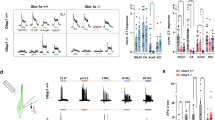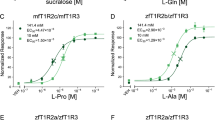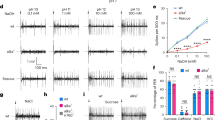Abstract
TASTE can be divided into four primary sensations: salty, sour, sweet and bitter. Salty and sour are directly transduced by apical channels1–4, whereas sweet and bitter utilize cyclic nucleotide second messengers5–11. We have shown that rod transducin is present in mammalian taste receptor cells, where it is activated by a bitter receptor and in turn activates a phosphodiesterase12. Here we introduce into frog taste cells peptides derived from transducin's phosphodiesterase–interaction region, which cause an inward whole–cell current in a subset of cells. We find that the peptides' effects are reversibly suppressed by IBMX and forskolin, indicative of a transducin-activated phosphodiesterase. Cyclic nucleotides suppress the whole-cell current, indicating that cyclic nucleotides may regulate taste-cell conductance. IBMX modifies taste-cell responses to two taste stimuli, implicating phosphodiesterase in taste transduction. Submicromolar cyclic nucleotides directly suppress the conductance of inside-out patches derived from the taste-cell plasma membrane, independently of protein phosphorylation. The channels are unusual in that they are suppressed, rather than activated by cyclic nucleotides. We propose that transducin, via phosphodiesterase, decreases cyclic nucleotide levels to activate the cyclic-nucleotide-suppressible conductance, leading to Ca2+ influx and taste-cell depolarization.
This is a preview of subscription content, access via your institution
Access options
Subscribe to this journal
Receive 51 print issues and online access
$199.00 per year
only $3.90 per issue
Buy this article
- Purchase on Springer Link
- Instant access to full article PDF
Prices may be subject to local taxes which are calculated during checkout
Similar content being viewed by others
References
Kinnamon, S. C. Trends Neurosci. 11, 491–496 (1988).
Avenet, P. & Lindemann, B. J. Membr. Biol. 112, 1–8 (1989).
Gilbertson, T. A. Curr. Opin. Neurobiol. 3, 532–539 (1993).
Margolskee, R. F. Curr. Opin. Neurobiol. 3, 526–531 (1993).
Kurihara, K. FEBS Lett. 27, 279–281 (1972).
Price, S. Nature 241, 54–55 (1973).
Tonosaki, K. & Funakoshi, M. Nature 331, 354–356 (1988).
Striem, B. J., Pace, V., Zehavi, V., Naim, M. & Lancet, D. Biochem. J. 260, 121–126 (1989).
Striem, B. J., Naim, M. & Lindemann, B. Cell. Physiol. Biochem. 1, 46–54 (1991).
Cummings, T. A., Powell, J. & Kinnamon, S. C. J. Neurophys. 70, 2326–2336 (1993).
Avenet, P., Hofmann, F. & Lindemann, B. Nature 331, 351–354 (1988).
Ruiz-Avila, L. et al. Nature 376, 80–85 (1995).
McLaughlin, S. K., McKinnon, P. J. & Margolskee, R. F. Nature 357, 563–569 (1992).
Rarick, H. M., Artemyev, N. O. & Hamm, H. E. Science 256, 1031–1033 (1992).
Spickofsky, N. et al. Nature struct. Biol. 1, 771–781 (1994).
Tang, J. M., Wang, J., Quandt, F. N. & Eisenberg, R. S. Pflügers Arch. 416, 347–350 (1990).
Herness, M. S. Neurosci. Soc. Abstr. 19, 1428 (1993).
Fesenko, E. F., Kolesnikov, S. S. & Lyubarsky, A. L. Nature 313, 310–313 (1985).
Haynes, L. W. & Yau, K.-W. Nature 317, 61–64 (1985).
Nakamura, T. & Gold, G. H. Nature 325, 442–444 (1987).
Kolesnikov, S. S., Rebric, T. I., Zhainazarov, A. B., Tavarkiladze, G. A. & Kalamkarov, G. R. FEBS Lett. 290, 167–170 (1991).
Biel, M. et al. Proc. natn. Acad. Sci. U.S.A. 91, 3505–3509 (1994).
Avenet, P. & Lindemann, B. J. Membr. Biol. 97, 223–240 (1989).
Stryer, L. J. biol. Chem. 266, 10711–10714 (1991).
McBride, D. W. Jr & Roper, S. D. J. Membr. Biol. 124, 85–93 (1991).
Fabiato, A. & Fabiato, F. J. Physiol., Paris 75, 463–505 (1979).
Kalinoski, D. L., Huque, T., LaMorte, V. J. & Brand, J. G. in Chemical Senses: Molecular Aspects of Taste and Odor Reception (eds Brand, J. G., Teeter, J. H., Cagan, M. R. & Kare, M. R.) 85–101 (Dekker, New York, 1989).
Sklar, P. B., Anholt, R. R. H. & Snyder, S. H. J. biol. Chem. 261, 15538–15543 (1986).
Author information
Authors and Affiliations
Rights and permissions
About this article
Cite this article
Kolesnikov, S., Margolskee, R. A cyclic–nucleotide–suppressible conductance activated by transducin in taste cells. Nature 376, 85–88 (1995). https://doi.org/10.1038/376085a0
Received:
Accepted:
Issue Date:
DOI: https://doi.org/10.1038/376085a0
This article is cited by
-
An alternative pathway for sweet sensation: possible mechanisms and physiological relevance
Pflügers Archiv - European Journal of Physiology (2020)
-
ROS-GC subfamily membrane guanylate cyclase-linked transduction systems: taste, pineal gland and hippocampus
Molecular and Cellular Biochemistry (2010)
-
Detection and localization of a putative cyclic-GMP-activated channel protein in the protozoan ciliate Stentor coeruleus
Protoplasma (2006)
-
A taste for umami
Nature Neuroscience (2000)
-
Gγ13 colocalizes with gustducin in taste receptor cells and mediates IP3 responses to bitter denatonium
Nature Neuroscience (1999)
Comments
By submitting a comment you agree to abide by our Terms and Community Guidelines. If you find something abusive or that does not comply with our terms or guidelines please flag it as inappropriate.



